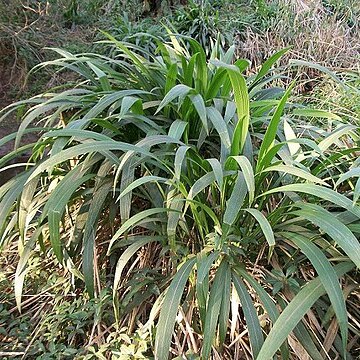Very tall, robust, tufted, shortly rhizomatous perennial, 0.9-3.0 m high; culm erect and occasionally rooting at nodes, 4-10 mm in diam., nodes glabrous. Leaf blade 150-800 x 10-110 mm, lanceolate, conspicuously and coarsely plicate, sometimes pseudopetiolate, sparsely hairy with tubercle-based hairs; ligule a fringed membrane or a fringe of hairs. Inflorescence an open panicle, 400-600 mm long; spikelets subtended by a solitary slender bristle; bristle 3-15 mm long, finely scabrid persisting on axis after spikelets fall. Spikelets 2-3 mm long, dorsiventrally compressed; lower glume 3-nerved. Florets 2; lower floret male or sterile, lemma firmly membranous; upper floret bisexual, lemma indurated, usually smooth, often shining, sometimes rugose at base, rarely rugose throughout, entire; anther 1.8 mm long. Flowering time Sept.-May.
Very tall, robust, tufted perennial 900-3000 mm high; rhizome short; culm 4-10 mm in diameter, erect, occasionally rooting at nodes, nodes glabrous. Leaf blade 150-800 x 10-110 mm, lanceolate, conspicuously and coarsely plicate, sometimes pseudopetiolate, sparsely hairy with tubercle-based hairs; leaf sheath usually densely hairy or at least margins hairy. Inflorescence 400-600 mm long, open; bristles solitary, slender, 3-15 mm long, finely scabrid. Spikelet 2-3 mm long; lower glume 3-nerved; lower lemma firmly membranous; upper lemma usually smooth, often shining, sometimes rugose at the base, rarely rugose throughout; anther 1.8 mm long.
Very tall, robust perennial, shortly rhizomatous and tufted (culms erect and occasionally rooting at nodes), up to 3 m high. Leaf blades 150-800 mm long, 10-110 mm wide, lanceolate, conspicuously plicate, leaf sheaths usually densely pubescent or at least with hairy margins. Culms 4-10 mm in diameter, nodes glabrous. Spikelets 2-3 mm long. Panicle open, 400-600 mm long; bristles solitary; lower glume 3-nerved.
Panicle 10–60 cm. long, linear to lanceolate, the branches short (occasionally the lowest long and flexuous) and ascending close to the rhachis or projecting laterally like a pagoda; bristles 3–15 mm. long.
A grass. It keeps growing from year to year and grows 1-3 m tall. It forms large clumps. The leaves are 15-80 cm long by 1-11 cm wide.
Superior lemma usually smooth and often shining, sometimes rugose below, rarely rugose throughout, becoming light brown.
Leaf laminae 5–110 mm. wide, broadly linear to narrowly lanceolate, conspicuously plicate, sometimes falsely petiolate.
Spikelets 2.2–3(3.5) mm. long, narrowly ovate to elliptic, acute.
Inferior glume 1/3–1/2, the superior 1/2–3/4 length of spikelet.
Inferior lemma firmly membranous, as long as the superior.
Culms 0.5–3 m. high and 2–10 mm. in diam. at the base.
Tufted perennial, often forming large clumps.

